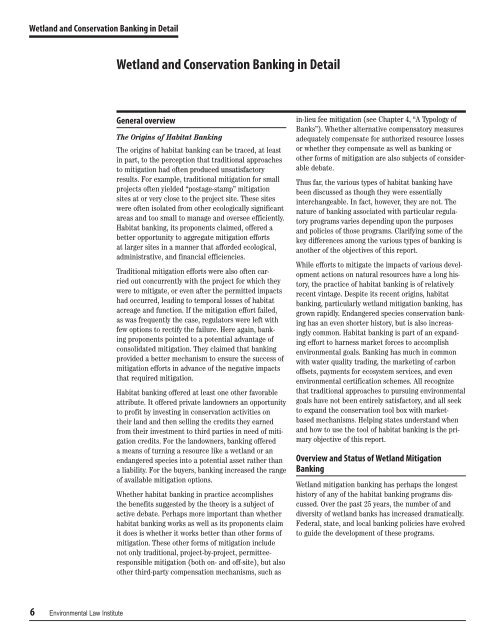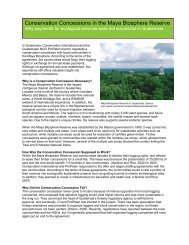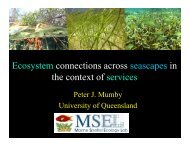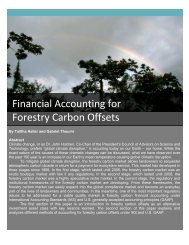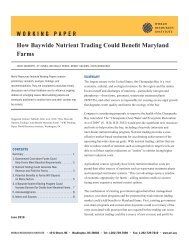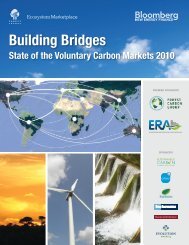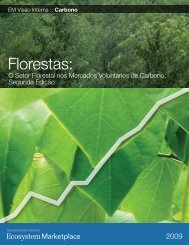Wetland and <strong>Conservation</strong> <strong>Banking</strong> in DetailWetland and <strong>Conservation</strong> <strong>Banking</strong> in DetailGeneral overviewThe Origins <strong>of</strong> <strong>Habitat</strong> <strong>Banking</strong>The origins <strong>of</strong> habitat banking can be traced, at leastin part, <strong>to</strong> <strong>the</strong> perception that traditional approaches<strong>to</strong> mitigation had <strong>of</strong>ten produced unsatisfac<strong>to</strong>ryresults. For example, traditional mitigation for smallprojects <strong>of</strong>ten yielded “postage-stamp” mitigationsites at or very close <strong>to</strong> <strong>the</strong> project site. These siteswere <strong>of</strong>ten isolated from o<strong>the</strong>r ecologically significantareas and <strong>to</strong>o small <strong>to</strong> manage and oversee efficiently.<strong>Habitat</strong> banking, its proponents claimed, <strong>of</strong>fered abetter opportunity <strong>to</strong> aggregate mitigation effortsat larger sites in a manner that afforded ecological,administrative, and financial efficiencies.Traditional mitigation efforts were also <strong>of</strong>ten carriedout concurrently with <strong>the</strong> project for which <strong>the</strong>ywere <strong>to</strong> mitigate, or even after <strong>the</strong> permitted impactshad occurred, leading <strong>to</strong> temporal losses <strong>of</strong> habitatacreage and function. If <strong>the</strong> mitigation effort failed,as was frequently <strong>the</strong> case, regula<strong>to</strong>rs were left withfew options <strong>to</strong> rectify <strong>the</strong> failure. Here again, bankingproponents pointed <strong>to</strong> a potential advantage <strong>of</strong>consolidated mitigation. They claimed that bankingprovided a better mechanism <strong>to</strong> ensure <strong>the</strong> success <strong>of</strong>mitigation efforts in advance <strong>of</strong> <strong>the</strong> negative impactsthat required mitigation.<strong>Habitat</strong> banking <strong>of</strong>fered at least one o<strong>the</strong>r favorableattribute. It <strong>of</strong>fered private landowners an opportunity<strong>to</strong> pr<strong>of</strong>it by investing in conservation activities on<strong>the</strong>ir land and <strong>the</strong>n selling <strong>the</strong> credits <strong>the</strong>y earnedfrom <strong>the</strong>ir investment <strong>to</strong> third parties in need <strong>of</strong> mitigationcredits. For <strong>the</strong> landowners, banking <strong>of</strong>fereda means <strong>of</strong> turning a resource like a wetland or anendangered species in<strong>to</strong> a potential asset ra<strong>the</strong>r thana liability. For <strong>the</strong> buyers, banking increased <strong>the</strong> range<strong>of</strong> available mitigation options.Whe<strong>the</strong>r habitat banking in practice accomplishes<strong>the</strong> benefits suggested by <strong>the</strong> <strong>the</strong>ory is a subject <strong>of</strong>active debate. Perhaps more important than whe<strong>the</strong>rhabitat banking works as well as its proponents claimit does is whe<strong>the</strong>r it works better than o<strong>the</strong>r forms <strong>of</strong>mitigation. These o<strong>the</strong>r forms <strong>of</strong> mitigation includenot only traditional, project-by-project, permitteeresponsiblemitigation (both on- and <strong>of</strong>f-site), but alsoo<strong>the</strong>r third-party compensation mechanisms, such asin-lieu fee mitigation (see Chapter 4, “A Typology <strong>of</strong>Banks”). Whe<strong>the</strong>r alternative compensa<strong>to</strong>ry measuresadequately compensate for authorized resource lossesor whe<strong>the</strong>r <strong>the</strong>y compensate as well as banking oro<strong>the</strong>r forms <strong>of</strong> mitigation are also subjects <strong>of</strong> considerabledebate.Thus far, <strong>the</strong> various types <strong>of</strong> habitat banking havebeen discussed as though <strong>the</strong>y were essentiallyinterchangeable. In fact, however, <strong>the</strong>y are not. Thenature <strong>of</strong> banking associated with particular regula<strong>to</strong>ryprograms varies depending upon <strong>the</strong> purposesand policies <strong>of</strong> those programs. Clarifying some <strong>of</strong> <strong>the</strong>key differences among <strong>the</strong> various types <strong>of</strong> banking isano<strong>the</strong>r <strong>of</strong> <strong>the</strong> objectives <strong>of</strong> this report.While efforts <strong>to</strong> mitigate <strong>the</strong> impacts <strong>of</strong> various developmentactions on natural resources have a long his<strong>to</strong>ry,<strong>the</strong> practice <strong>of</strong> habitat banking is <strong>of</strong> relativelyrecent vintage. Despite its recent origins, habitatbanking, particularly wetland mitigation banking, hasgrown rapidly. Endangered species conservation bankinghas an even shorter his<strong>to</strong>ry, but is also increasinglycommon. <strong>Habitat</strong> banking is part <strong>of</strong> an expandingeffort <strong>to</strong> harness market forces <strong>to</strong> accomplishenvironmental goals. <strong>Banking</strong> has much in commonwith water quality trading, <strong>the</strong> marketing <strong>of</strong> carbon<strong>of</strong>fsets, payments for ecosystem services, and evenenvironmental certification schemes. All recognizethat traditional approaches <strong>to</strong> pursuing environmentalgoals have not been entirely satisfac<strong>to</strong>ry, and all seek<strong>to</strong> expand <strong>the</strong> conservation <strong>to</strong>ol box with marketbasedmechanisms. Helping states understand whenand how <strong>to</strong> use <strong>the</strong> <strong>to</strong>ol <strong>of</strong> habitat banking is <strong>the</strong> primaryobjective <strong>of</strong> this report.Overview and Status <strong>of</strong> Wetland Mitigation<strong>Banking</strong>Wetland mitigation banking has perhaps <strong>the</strong> longesthis<strong>to</strong>ry <strong>of</strong> any <strong>of</strong> <strong>the</strong> habitat banking programs discussed.Over <strong>the</strong> past 25 years, <strong>the</strong> number <strong>of</strong> anddiversity <strong>of</strong> wetland banks has increased dramatically.Federal, state, and local banking policies have evolved<strong>to</strong> guide <strong>the</strong> development <strong>of</strong> <strong>the</strong>se programs.6 Environmental Law Institute
WETLAND AND CONSERVATION BANKING IN DETAILPolicy overviewSection 404 <strong>of</strong> <strong>the</strong> Clean Water Act (CWA) prohibits<strong>the</strong> discharge <strong>of</strong> any dredged or fill material in “waters<strong>of</strong> <strong>the</strong> United States,” 1 including wetlands, without apermit. 2 The §404 program is carried out by <strong>the</strong> Corpswith oversight by <strong>the</strong> U.S. Environmental ProtectionAgency (EPA). Day-<strong>to</strong>-day permit processing is carriedout by <strong>the</strong> Corps’ 38 district <strong>of</strong>fices (see Fig. 1). 3Administration <strong>of</strong> <strong>the</strong> §404 program is guided bytwo national goals: (1) <strong>the</strong> 1972 CWA’s purpose, “<strong>to</strong>res<strong>to</strong>re and maintain <strong>the</strong> chemical, physical, and biologicalintegrity <strong>of</strong> <strong>the</strong> Nation’s waters,” 4 “including1 33 U.S.C. § 1311; CWA § 301. “’[W]aters <strong>of</strong> <strong>the</strong> United States’means (1) All waters which are currently used, or were used in<strong>the</strong> past, or may be susceptible <strong>to</strong> use in interstate or foreigncommerce, including all waters which are subject <strong>to</strong> <strong>the</strong> ebb andflow <strong>of</strong> <strong>the</strong> tide; (2) All interstate waters including interstatewetlands; (3) All o<strong>the</strong>r waters such as intrastate lakes, rivers,streams (including intermittent streams), mudflats, sandflats,wetlands, sloughs, prairie potholes, wet meadows, playa lakes, ornatural ponds, <strong>the</strong> use, degradation or destruction <strong>of</strong> which couldaffect interstate or foreign commerce including any such waters:(i) Which are or could be used by interstate or foreign travelers forrecreational or o<strong>the</strong>r purposes; or (ii) From which fish or shellfishare or could be taken and sold in interstate or foreign commerce;or (iii) Which are used or could be used for industrial purpose byindustries in interstate commerce; (4) All impoundments <strong>of</strong> waterso<strong>the</strong>rwise defined as waters <strong>of</strong> <strong>the</strong> United States under <strong>the</strong> definition;(5) Tributaries <strong>of</strong> waters identified in paragraphs (a) (1)through (4) <strong>of</strong> this section; (6) The terri<strong>to</strong>rial seas; (7) Wetlandsadjacent <strong>to</strong> waters (o<strong>the</strong>r than waters that are <strong>the</strong>mselves wetlands)identified in paragraphs (a) (1) through (6) <strong>of</strong> this section.”33 C.F.R. § 328.3.2 33 U.S.C. § 1344; CWA §404.3 Congress created <strong>the</strong> § 404 program in 1972 with authority dividedbetween <strong>the</strong> Corps and <strong>the</strong> EPA. The Corps plays <strong>the</strong> lead rolein <strong>the</strong> § 404 program through its authority <strong>to</strong> require and issuepermits for <strong>the</strong> discharge <strong>of</strong> dredged or fill material in<strong>to</strong> wetlandsand o<strong>the</strong>r waters. The Corps also conducts or verifies jurisdictionaldeterminations and shares enforcement responsibilities with EPA.33 C.F.R. § 325.9. EPA is responsible for developing and interpreting<strong>the</strong> environmental criteria used by <strong>the</strong> Corps <strong>to</strong> evaluatepermit applications and maintains a review and comment role in<strong>the</strong> issuance <strong>of</strong> § 404 permits. EPA is also responsible for determining<strong>the</strong> geographic scope <strong>of</strong> jurisdiction and <strong>the</strong> applicability <strong>of</strong>exemptions, approving and overseeing state and tribal assumption<strong>of</strong> <strong>the</strong> permitting program, and shares enforcement responsibilitieswith <strong>the</strong> Corps. 33 U.S.C. § 1344; CWA § 404. Finally, EPA has <strong>the</strong>authority <strong>to</strong> ve<strong>to</strong> permit decisions under § 404(c), as well as <strong>the</strong>authority <strong>to</strong> elevate permit decisions under § 404(q). 33 U.S.C. §§1344 (c), 1344(q); CWA §§ 404(c), (q).4 33 U.S.C. § 1251(a); CWA § 101(a).wetlands”; 5 and (2) <strong>the</strong> national goal, set in 1989, <strong>of</strong>achieving a “no overall net loss” <strong>of</strong> wetland acres andfunctions. 6 The national no net loss policy has beenreinforced in subsequent federal wetland compensa<strong>to</strong>rymitigation policy. 7 Because <strong>of</strong> <strong>the</strong> difficulty inherentin even measuring, let alone replacing, functions,federal policy suggests that a minimum one-<strong>to</strong>-oneacreage replacement may be used as a reasonable surrogatefor no net loss <strong>of</strong> functions. 8The no net loss policy significantly influences how <strong>the</strong>regula<strong>to</strong>ry agencies make compensa<strong>to</strong>ry mitigationdecisions. In particular, <strong>the</strong> agencies may limit <strong>the</strong>extent <strong>to</strong> which <strong>the</strong>y allow permittees <strong>to</strong> rely on preservationas <strong>the</strong> sole or even primary mechanism formeeting <strong>the</strong>ir compensa<strong>to</strong>ry mitigation requirements.Thus, <strong>the</strong> state wildlife action plans’ primary focus on<strong>the</strong> protection <strong>of</strong> intact, high quality wildlife habitat,ra<strong>the</strong>r than <strong>the</strong> res<strong>to</strong>ration <strong>of</strong> degraded habitat, mayrestrict <strong>the</strong> usefulness <strong>of</strong> <strong>the</strong> plans in guiding <strong>the</strong> siting<strong>of</strong> wetland mitigation banks. The role <strong>of</strong> preservationin <strong>the</strong> wetland compensa<strong>to</strong>ry mitigation programis discussed fur<strong>the</strong>r below (see Chapter 2, “Policyoverview”).5 U.S. Environmental Protection Agency and U.S. Department <strong>of</strong> <strong>the</strong>Army. February 6, 1990. Memorandum <strong>of</strong> Agreement Between <strong>the</strong>Environmental Protection Agency and <strong>the</strong> Department <strong>of</strong> <strong>the</strong> ArmyConcerning <strong>the</strong> Determination <strong>of</strong> Mitigation Under <strong>the</strong> Clean WaterAct Section 404(b)(1) Guidelines. (Hereinafter Mitigation MOA(1990).)6 The national goal <strong>of</strong> achieving no net loss <strong>of</strong> wetland acres andfunctions was first expressed in <strong>the</strong> report, “Protecting AmericasWetlands: An Action Agenda <strong>the</strong> Final Report <strong>of</strong> <strong>the</strong> NationalWetlands Policy Forum.” 1988. Washing<strong>to</strong>n, DC: The <strong>Conservation</strong>Fund. The report recommended that “<strong>the</strong> nation establish a nationalwetlands protection policy <strong>to</strong> achieve no overall net loss <strong>of</strong> <strong>the</strong>nation’s remaining wetlands base, as defined by acreage and function,and <strong>to</strong> res<strong>to</strong>re and create wetlands, where feasible, <strong>to</strong> increase<strong>the</strong> quality and quantity <strong>of</strong> <strong>the</strong> nation’s wetlands resource base.” OnJune 6, 1989, President H.W. Bush <strong>of</strong>ficially articulated no net lossas a national policy goal in a speech <strong>to</strong> Ducks Unlimited.7 Mitigation MOA (1990); U.S. Army Corps <strong>of</strong> Engineers and <strong>US</strong>Environmental Protection Agency. December 24, 2002. Guidanceon Compensa<strong>to</strong>ry Mitigation Projects for Aquatic Resource ImpactsUnder <strong>the</strong> Corps Regula<strong>to</strong>ry Program Pursuant <strong>to</strong> Section 404 <strong>of</strong> <strong>the</strong>Clean Water Act and Section 10 <strong>of</strong> <strong>the</strong> Rivers and Harbors Act <strong>of</strong>1899. Regula<strong>to</strong>ry Guidance Letter No. 02-2. (Hereinafter RGL 02-2(2002).)8 RGL 02-2 (2002).<strong>Design</strong> <strong>of</strong> U.S. <strong>Habitat</strong> <strong>Banking</strong> <strong>Systems</strong> <strong>to</strong> <strong>Support</strong> <strong>the</strong> <strong>Conservation</strong> <strong>of</strong> Wildlife <strong>Habitat</strong> and At-Risk Species 7


